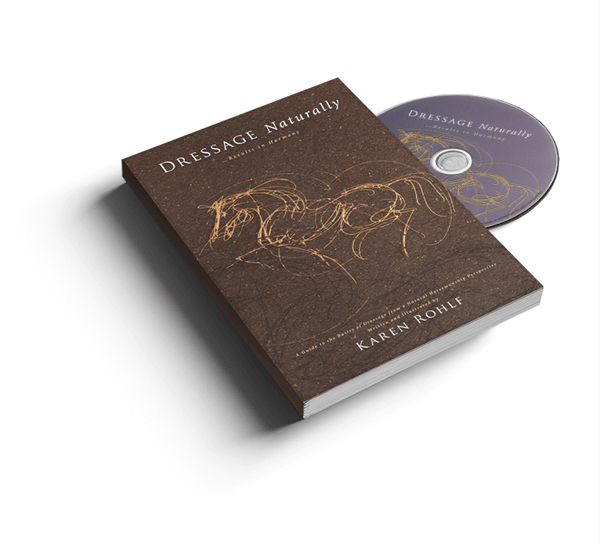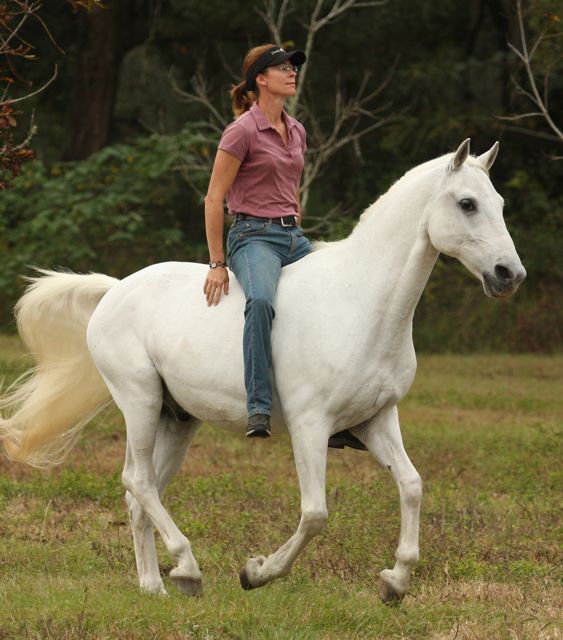
Self-carriage is one of those qualities that, no matter what discipline you are doing, makes you say: "Wow, this horse feels great!" It is usually defined as something like: "When the horse is balanced and maintaining himself without needing support from the rider's hands". In dressage, it is typically thought to be a result of a well ridden half halt, but it has just as much to do with being balanced mentally and emotionally as it does with being balanced physically.
As a professional dressage trainer and natural horseman, I have learned to take a broader look at the quality of self-carriage; how it is created and what is necessary for it to happen. With Dressage, Naturally, I look at the mind, emotions and body of the horse. Self-carriage is more than just a way of carrying the body.
Is self-carriage an elusive quality that we must train for years to feel, hoping to maintain to for even a few magical strides? No. It is a quality that can be practiced immediately and in more situations than you may think. Of course, as you ask your horse to expand and learn more challenging maneuvers, there will be times that self carriage is difficult due to his lack of coordination, understanding, balance or strength in that particular movement. It is a good test to see how well we have prepared and developed our horse for what we are asking.
Let's look at what is happening during moments of self-carriage.
The Horse in Self-Carriage:
- Physically: The horse has his body balanced in a way that is appropriate for the movement he is doing. His hind legs are engaged and carrying his body. His spine is free from excess tension. He is aligned in a way that his weight is not falling forward or sideways or hanging back.
- Mentally: He understands what is required of him and so is able to organize his body for the task. There is no lack of balance due to him not being sure where he is going or what he is being asked to do.
- Emotionally: He is comfortable and calm and so feels no need to escape where he is, or be anywhere else. He is not fearful of making a mistake and therefore can be looser and more supple in his body. This will allow him to make the subtle adjustments necessary to remain in perfect balance. He trusts that he can settle into what he is doing, knowing he will always be given a warning when something new is going to be asked.
And, just as importantly ... he hopefully has a human attached to him that is not throwing him off balance mentally, emotionally or physically!
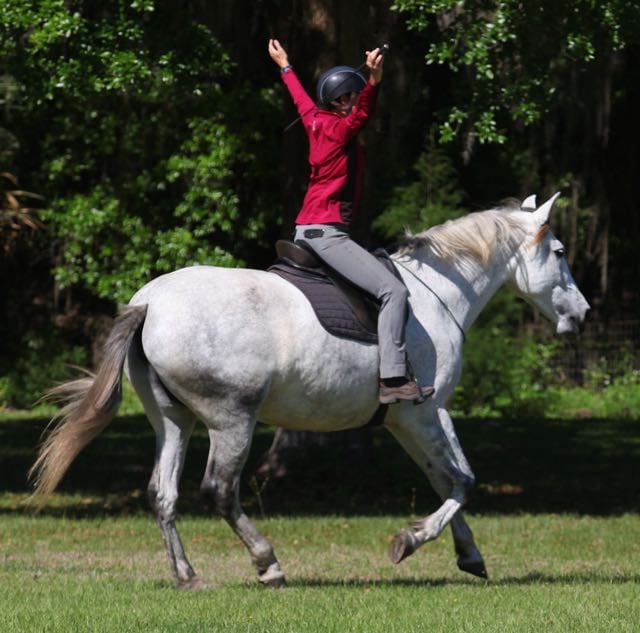
The Rider in Self-Carriage:
- Physically: The rider has his body balanced in a way that is appropriate for the movement he is doing and he is able to follow the horse's movement as it is performed. He can do this without gripping or holding onto the reins for balance. He can be silent and neutral with his aids when the horse is doing what he asked. Being neutral in self-carriage is something in between giving no information (leaving your horse wondering what to do) and micromanaging him every step of the way (leaving him feeling helpless).
- Mentally: The rider understands how to ride the movement and apply appropriate, non-conflicting aids. He is focused and clear in his communication. He can recognize when his horse is in a good enough balance for the movement he is doing.
- Emotionally: The rider is comfortable and calm and is confident in his ability to ride what he is asking his horse for. He is not fearful of the horse or situation and therefore can be looser and more supple in his body. This will allow him to make the subtle adjustments necessary to remain in perfect balance. He is riding with patience and not from ego, and so will not be forcing his horse past his capabilities.
As you can see, there could be many reasons why a horse is not in self-carriage! If self-carriage is lacking, we must take some care to evaluate what the cause is, and know that there may be different strategies for improvement, depending on what it is.
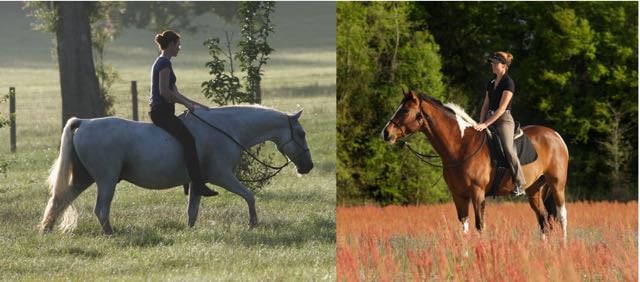
Let's take a very simple movement to illustrate a concept. The movement will be standing still on a loose rein. Not a "perfect square halt", but just simply standing still. I see this so often — The student rides out to me to have their lesson, I ask them some questions about what they would like to work on and the horse is standing, then walking off, then standing for a moment somewhere else, then walking in a circle, then leaving ... you get the picture. So I ask if they can please stand still while we talk and the rider shortens up the reins and holds her horse in one place (with varying degrees of success). Already, it is clear that there are self-carriage issues! And this is during something very easy! Usually what ever is happening while standing still is also happening during movement. In this case, the horse is never quite where the rider suggests, is not calm and attentive and, in order to really get it done, she must hold on with her hands. Not exactly a good recipe for self-carriage. I would be willing to bet he also didn't stand quietly while being groomed ... perhaps he was up against the cross ties already practicing lack of self carriage and feeling controlled.
I put a fairly high priority on solving this issue. One strategy could be to totally control the horse. Physically, not let his body move. Hold him there. If you were a quick, strong, effective enough rider, you could possibly prevent him from moving. But it wouldn't necessarily change his mind for the next time, unless he resolved and then relaxed. This could work for a fairly non-emotional horse. The trouble is, if he is emotional, he could "blow". And resolved isn't really a trait I want to strive for. Plus, we are being conflicting, because in the moment we are trying to convey the idea, "Hey, just relax", we are also having to be very strong and activated in our body.
A strategy I use is to pick a place on the ground, go to it, stop, totally relax, trust him by dropping the reins and expect him to stop and relax. If he walks off, I spring to action, move his feet to quickly get back to that particular place on the ground and when I get there, stop, drop the reins, relax and trust. Repeat as necessary! To make it more obvious, sometimes I build a box with poles or cones. It is a mental/emotional exercise to have the horse with me in self-carriage during relaxation. This will help his mind understand, "Oh, every time we are here, she stops and relaxes". He has already told me he doesn't understand or respect that communication of "be here with me", so it is worth taking the time to follow through until he does. Isn't that what self-carriage really is: "Be exactly here with me"? If he can't be here with me in self-carriage during something as simple as standing still, chances are he doesn't get the concept, and I will be dealing with it every stride of everything we do. I need to make the decision that I am not going to hold his body for him. He is free ... to stay or change. But I set up the exercise in a way that in the end, he decides to stay.
You can do the above exercise even with an emotional, claustrophobic horse, as it never makes the horse feel trapped. It works fairly quickly and does the same thing for the horse as it would for a nervous, fidgety student, if I took the time to connect and say, "Hey, look at me, take a deep breathe, relax!"

This is, of course, self-carriage in its most exaggerated, basic form, but it is refine-able. Later during a movement you won't have to stop and drop the reins to find out if your horse is in self-carriage. You will begin to recognize the feeling you get from your horse that he would stay with you if you dropped the reins. In the dressage Third Level competition tests, there is a movement where the rider is asked to show a "clear release of the inside rein" for approximately 10 meters at the canter. That is testing the self-carriage. A horse that can do that well has developed the mental/emotional/physical ability to be exactly "here with" his rider even at the collected canter, on a precise circle. By giving the rein, we prove it. If he can't hold his balance there, is an adjustment you can make that will help him become more capable? Ask yourself, was he not understanding/respecting? Was he emotionally distracted/tense? Was he physically crooked/misaligned? Then you can make an appropriate, meaningful correction that will make next time better.
The mind and the body are connected and I am constantly amazed at how a horse's bio-mechanics and balance can change when they are mentally and emotionally prepared and engaged. In the example above, chances are, when the horse relaxes (emotionally) and understands (mentally) there is a good chance he is also standing squarely (physically) in his body. I am also amazed at how often my horse's nervousness and tension are simply due to my own unbalance and miscommunication or the horse's lack of balance or strength (An example of that would be riding a horse into a halt, but your body or your horse's body is off balance or lacking engagement, causing the horse to step to the side, backwards or trickle forward, then he gets nervous because you make a strong correction after the fact).
It is our top priority as riders to embody what we are asking for and be able to lead our horse well through the movements we ask of him, like the best dance partner in the world. It is not our job to physically hold them there. Every moment that we hold on, preventing an imagined, potential "mistake", we are cheating our horse from feeling true lightness. We are telling him we don't trust his abilities, which is saying that we don't trust ourselves, as we are the ones who are responsible for developing his abilities!
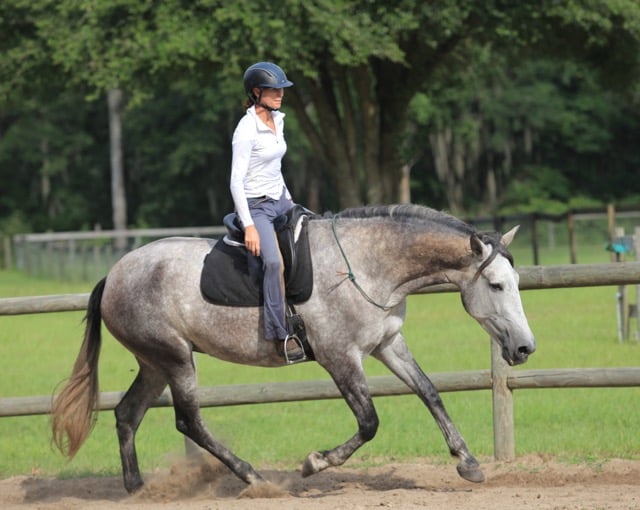
Don’t be afraid to let go of your horses and get the truth! Let go for an entire ride or for a few strides here and there, but let go! For me, the practice of riding without the reins or the bridle has a huge benefit in that I must take care of the mental, emotional and physical self-carriage of the horse. The paradox is that letting go and trusting our horse may give us the opportunity to feel something horrible ... or something amazing. The more we trust our horses and prove we can ride their bodies with our bodies, the greater a chance we have of true self-carriage. You can experience it sooner than you think and preserve it as you develop.




